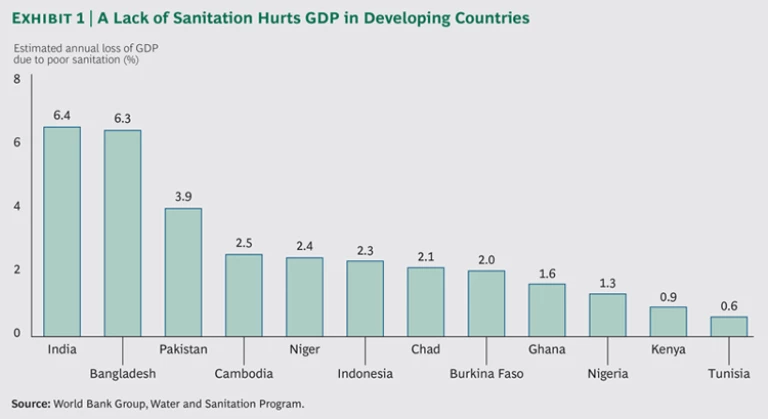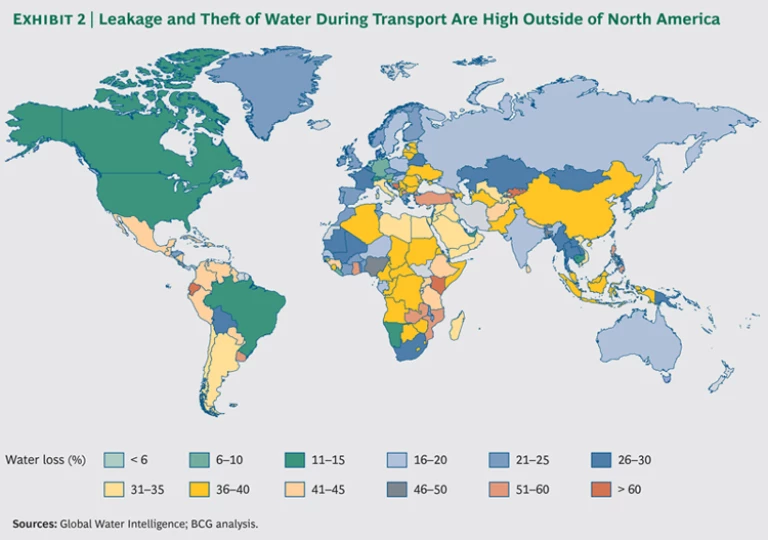If current predictions hold, 70 percent of the world’s population will live in cities by 2050. Fueling this urbanization trend is a massive number of people in emerging economies migrating from rural to urban areas in search of employment opportunities and a higher standard of living. Africa alone is expected to gain about 25 million new city dwellers per year through 2050, and Asia will add another 35 million. To survive and thrive, emerging cities in these developing regions must attract inflows of capital—and prevent outflows. Foreign investment is fundamental to economic health, promoting growth, innovation, and tax revenues, and creating new jobs.
Given the large number of cities competing for capital, what does it take to draw investment and new businesses? Two major factors are an available workforce and infrastructure—and sanitation services are essential to both. Cities with effective sanitation management are cleaner and more livable, and have healthier populations. By contrast, the health consequences of poor sanitation are staggering. More children die every year from diarrhea caused by poor sanitation than from measles, malaria, and HIV/AIDS combined. Even when diarrhea doesn’t kill, it can deplete the body of nutrients, stunt growth, cause children to miss school, and make people more susceptible to other diseases. The result is a decrease in healthy, well-educated, able-bodied citizens.
Investments in sanitation dramatically improve a city’s quality of life. Removing fecal sludge from the environment and properly treating human waste reduce a city’s pollution levels, eliminate the foul odor of open drains, and help curb disease outbreaks. Making better sanitation a priority pays off: low-income countries that invest in clean water and sanitation achieve annual average GDP growth of 3.7 percent, compared with only 0.1 percent for those that don’t. Nations that do not prioritize sanitation pay a significant economic price—in some cases, a loss of more than 6 percent of GDP. (See Exhibit 1.) According to the World Health Organization, just one dollar invested in water quality and sanitation yields an economic return of anywhere from $5 to $28, depending on the country. For these reasons, sanitation services are indispensable to a city’s development and competitive advantage.
The Sanitation Challenge
Since spending on sanitation is clearly a “good buy” from an economic standpoint, why haven’t developing countries made more progress in the past decade? Part of the problem is that the benefits of adequate sanitation aren’t readily apparent, and citizens often value other products and services more. Additionally, for the governments prioritizing sanitation efforts, the costs are daunting. Urban planners have typically focused on traditional sewage systems with flush toilets—the “gold standard” of sanitation—because they limit exposure to waste matter and carry minimal risk of environmental contamination when properly built and maintained. But sewage systems aren’t always a cost-effective solution for the developing world.
Besides being expensive to build and maintain, large sewer networks can entail per capita costs that are higher than originally anticipated. Since large networks are typically scaled up for future population growth, current customers must bear the carrying costs of sewer construction that will benefit future neighbors. This is a particular problem in developing economies, where most residents struggle to pay the connection fees. If not enough residents elect to connect, the total cost can be moderately to severely over plan, ranging from $220 to $940 per capita. Add the fact that ongoing sewer charges are commonly divided among all users equally in their water bills, and the net result is that the poorer members of society—who may not be able to afford the connection fees or may lack access because the sewers don’t extend into their neighborhoods—end up financing sewer maintenance for wealthier individuals. Although some countries use a progressive pricing system, collecting sewer revenues through water bills almost invariably leads to poor customers paying for a service they never receive.
What’s more, simply building a sewage system doesn’t ensure the proper treatment of wastewater—or a clean environment. For instance, a recent study in Southeast Asia showed that only 2 to 30 percent of all collected waste was actually treated before being released into local bodies of water. In some cases, the problem is that the revenue from water bills doesn’t cover the system’s operating costs, which generally run between $14 and $28 per person per year in developing countries, where annual disposable income for the middle class often doesn’t exceed $1,000 per capita. In other cases, either the institutional capabilities needed to properly maintain and operate the treatment plants do not exist or trained personnel are lost over time through attrition, further compounding the problem. To address this issue, some cities are experimenting with hiring private-sector companies to manage the plants.
Looking forward, a greater challenge than covering the costs of a sewage system may be sourcing the water needed for it to function properly. While some cities have readily available sources of fresh water nearby, others must transport their water over long distances at great cost. Climate change is expected to exacerbate the situation by disrupting rainfall patterns and water availability in many areas, leading to greater unpredictability. Combined with other trends, such as depleting too much groundwater through excessive use of aquifers and overallocating surface water to household use, water scarcity may become an ongoing problem. Although water may be reallocated from agricultural or industrial uses toward domestic consumption in some regions, this may not always be possible, or it may not be cost-effective when sewage transport expenses are factored in. Since conventional sewage systems require large volumes of water, cities with water shortages, or with the potential for them, will need to carefully weigh the benefits against the risks—including the long-term sustainability of sewers as the primary sanitation option.
Another challenge with water as a waste conveyance mechanism, especially in Africa, is that most water utilities lose between 30 and 60 percent of their potable water as a result of leakage or theft during transport to end users, compared with only 11 to 15 percent in the U.S. and Canada. (See Exhibit 2.) These loss rates drive the cost of water higher. Even South Africa’s system, which is one of the best in Africa, loses 26 to 30 percent of its water volume to leakage and theft.
Besides requiring an extensive infrastructure, lots of water, and high up-front and maintenance costs for governments, sewage systems can take many years to build, are far more expensive than other options such as on-site septic tanks, and can’t achieve scale as quickly to address the large populations in need. Cities should therefore determine whether an emphasis on conventional sewage systems is right for their situation.
A Portfolio of Approaches
Given the rapid rate of urbanization in developing countries, emerging cities that fail to respond quickly to the resulting sanitation challenge will be at a growing disadvantage relative to more forward-looking municipalities. On the basis of our experience and observations, we recommend taking action on three fronts: developing solutions that go beyond sewers; using innovative technologies as they emerge; and engaging the private sector to provide sanitation services. Let’s explore each of these actions more closely.
Developing Solutions That Go Beyond Sewers
Because of the challenges that sewage systems present, many of the more enlightened municipalities are looking for alternatives. Two approaches that have been deployed on a large scale are decentralized sewer-based systems and on-site septic-tank systems.
Typically used in smaller neighborhoods, the decentralized sewer-based system has a simpler design than conventional sewers, can function with a lower rate of water flow, uses pipes with a smaller diameter, and requires smaller wastewater-treatment plants. Taken together, these features reduce the cost of installation and operation. On a per capita basis, decentralized sewer-based systems cost from $105 to $155 to build, and another $4 to $10 to operate per year. Since they can be introduced gradually according to an area’s ability to support them financially, these systems rarely suffer the same connection challenges as large sewage systems. Decentralized systems are widely used in Brazil and Malaysia in neighborhoods adjoining the major cities. However, these systems are prone to blockage because of their small pipe size, depend on neighborhood cooperation, and have not seen widespread global adoption.
The second common approach is the on-site septic-tank system, which is designed for a single household or to be shared among several households. The septic tank treats liquid waste and allows it to leach into the ground, where, under the right conditions, it will safely degrade. Solid waste collects in the tank and must be pumped out when the tank fills up. A challenge is ensuring that the removed solids are properly treated and not simply dumped into the environment. When correctly designed and regularly emptied, septic tanks are a relatively low-cost solution with limited environmental impact. Enforced codes can ensure that the systems are properly constructed.
On a per capita basis, septic-tank systems cost from $70 to $360, with most falling at the low end of the range. Annual operating costs—which largely involve emptying the contents of the tank—range from $4 to $12 per capita. Significant efforts are being made to develop innovative, more efficient technologies to reduce the cost of emptying the tanks. The need for on-site services to remove the solid waste has given rise to a “fecal sludge management” (FSM) market.
On-site systems (septic tanks and pit latrines) were the predominant sanitation method in European cities until the middle of the nineteenth century, when the first modern sewage systems emerged. Even today, on-site sanitation systems that rely on septic tanks and FSM are prevalent in rural and peri-urban areas (between the city and the rural regions) of Europe, North America, and Japan.
Some countries, including the Philippines, Malaysia, Senegal, Burkina Faso, and South Africa, are already moving away from a primarily sewer-based approach in their larger cities to a mix of decentralized and on-site solutions that are more easily scalable, more economical, and better suited to local conditions. Dakar, the capital of Senegal, uses a combination of centralized and decentralized sewers and on-site systems in different parts of the city.
Using Innovative Technologies as They Emerge
A number of innovative sanitation technologies are showing promise. Haiti, for instance, is using Ecosan toilets to turn human waste into compost. Ecosan’s waterless toilets and urine-diverting dry toilets have potential as large-scale solutions but are not yet part of most cities’ sanitation portfolios. These solutions don’t require water (and, in fact, discourage its use). Many of these toilets are used in rural and peri-urban areas in developing and developed countries alike but have not yet proved to be effective on a large scale in densely populated urban areas—although studies are under way to test their feasibility. Many new technologies are experimenting with ways to collect and reuse solid waste.
One of the bolder moves is the Bill & Melinda Gates Foundation’s Reinvent the Toilet Challenge. This program is seeking self-contained, on-site sanitation solutions that can treat human waste, remove pathogens, and create valuable by-products by recovering nutrients, energy, and water from fecal sludge. Most of the program’s technologies are still in development and won’t be fully tested and ready for large-scale implementation for several years, but they offer intriguing options for the future. No matter which technologies are selected, all cities should test these innovations as they emerge and adopt the solutions that are best suited to their local needs and constraints.
Engaging the Private Sector to Provide Sanitation Services
Innovation is equally important on the service side. Companies in the private sector often play an important role in emptying septic tanks and managing sanitation systems—sometimes through agreements contracted through local governments. Senegal and Burkina Faso have made FSM an integral part of their urban sanitation strategies. Service innovations such as SMS-based operator dispatching or the prepayment of septic-tank emptying fees through water or utility bills can improve efficiencies and reduce costs. By coordinating and combining the waste removal of multiple household septic tanks, operators can plan their schedules more efficiently and optimize the use of expensive equipment. Innovations such as these are quite common in Southeast Asia.
Local governments can support more efficient, cost-effective private-sector services by building networks of well-located waste-treatment facilities. With proper planning, networks such as these could dramatically reduce trucking costs for service providers and thereby reduce incentives for illegal dumping. At the same time, the facilities could create new revenue streams by providing resource-recovery and reuse capabilities close to where the waste by-products can be used. These new sources of revenue could help reduce user fees. Resource recovery initiatives could also further encourage private operators to dump septage in environmentally safe places.
Resource recovery is a field that could benefit from the involvement of companies in the private sector. With the right incentives, companies could spearhead the development of more efficient recovery approaches and innovative ways to maximize the value of waste by-products. Today, such efforts typically revolve around water reuse and the creation of fertilizer, but new options such as creating biochar, biogas, and biodiesel are being explored. In an ideal world, private companies could develop technologies that produce highly valuable by-products, which would allow the entire sanitation system to be self-sustaining. In our experience, however, these approaches are struggling to reach profitability. Still, even modest cost reductions or offsets through the creation of value-added products would be an important contribution to the field.
Since the urban market for sanitation services will grow with population expansion and urbanization, forward-looking municipalities are recognizing the vital role that private-sector businesses can play—and are seeking to engage them. By profitably developing and offering safer sanitation products and services, private-sector businesses can relieve public-sector organizations of the sanitation burden. Moreover, these businesses can help boost the overall economy by providing stable jobs and incomes for local populations. Local governments should carefully weigh any tariffs and regulations that could curtail the growth of private-sector innovation and services in the sanitation arena, and seek to provide incentives instead—such as favorable import tariffs on vacuum trucks and other new sanitation equipment.
In the Philippines, cities such as Manila and San Fernando are using a diverse range of models for collaboration between government utilities and private-sector service providers. For instance, a portion of the water tariff collected by the government utility in San Fernando is used to fund a five-year cycle of septic-tank sludge removal by private operators. In Malaysia, the Indah Water Konsortium manages a network of centralized and decentralized sewage systems and is responsible for collecting and treating septage under a broad sanitation agreement with the government.
By using a portfolio of approaches—nonsewer solutions, emerging technologies, and private-sector services—cities can improve sanitation in a flexible, efficient, and cost-effective manner, rather than wait for economic prosperity. Prosperity will be hindered only by the health and economic handicaps of inadequate sanitation. As the wave of urbanization takes hold, the cleaner municipalities with the highest quality of living are the ones that will attract investment, jobs, innovation, and people. Better sanitation lays the foundation for economic progress.
For more information on the portfolio of solutions available to meet the sanitation challenge, see Urban Sanitation: Why a Portfolio of Solutions Is Needed , BCG Working Paper, December 2014.
Acknowledgments
Funding for this report was provided by the Bill & Melinda Gates Foundation and The Boston Consulting Group. The authors would like to thank Doulaye Koné, senior program officer at the Gates Foundation, for his input and guidance.









